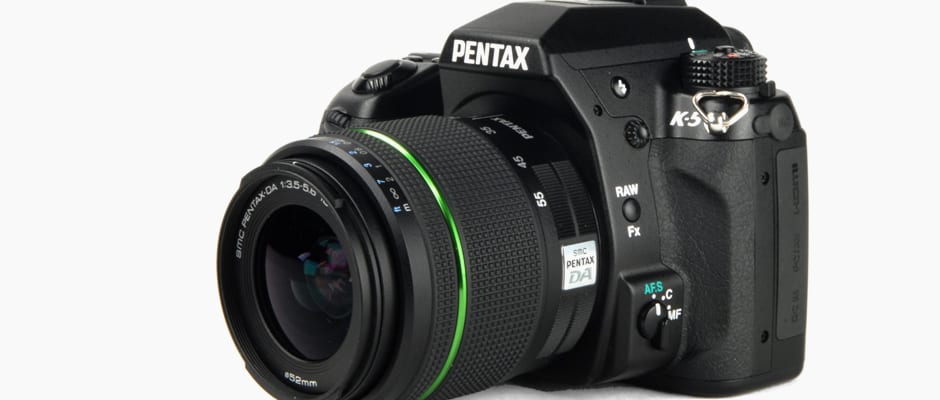Pros
Cons
Introduction
Tour
{{section_header}}{{section.name}}{{/section_header}}




LCD & Viewfinder
{{section_header}}{{section.name}}{{/section_header}}
The LCD for the K-5 is a large 3-inch screen on the back of the camera body. This has a resolution of 921k pixels, and looks very clean and sharp. We were not able to test it in bright daylight, but other similar screens have typically held up pretty well. Pentax has resisted the trend towards screens that rotate and flip on articulated arms: the screen of the K-5 is built into the camera body and cannot be moved or rotated.

On the top of the camera body is a secondary screen that shows the basic shooting information, which will make users of older film SLRs feel at home.

The K-5 is a true SLR with a mirror, so the viewfinder is an optical viewfinder that shows exactly what you see when shooting through the lens. Shooting information such as shutter speed, etc is overlaid on the bottom of the frame.

Flash
{{section_header}}{{section.name}}{{/section_header}}
There are two flash options on the K-5: a built-in flash or an external flash attached to the hot shoe on the top of the camera body. The built-in flash pops up when required, or can be manually released by pressing the button on the right side of the viewfinder housing. This pops up higher than most, so it should produce less red-eye effect than those that are close to the lens. We were not able to test the power of this flash, but Pentax claims that it has a guide number of 13 and covers enough area to illuminate the entire frame of a 28mm lens. That is reasonably powerful and should make it bright enough for everyday use, but we'll know more when we get a unit into our labs for testing.

The other option is to attach an external flash to the standard hot shoe on the top of the camera body. This will work with any standard flash, but Pentax sells a number of their own models which are designed to be more flexible, offering TTL (Through The Lens) metering for flash and synch speeds of up to 1/180 of a second.

Lens & Sensor
{{section_header}}{{section.name}}{{/section_header}}

Jacks, Ports & Plugs
{{section_header}}{{section.name}}{{/section_header}}
There are a good number of ports and sockets on the K-5. On the left side we have an external microphone port, a mini HDMI port, a combined analog video/USB port and a power input. On the right is an additional port for connecting the remote control device. All of the ports are covered by robust feeling plastic covers that snap satisfyingly into place, and are unlikely to let any dust or moisture through.
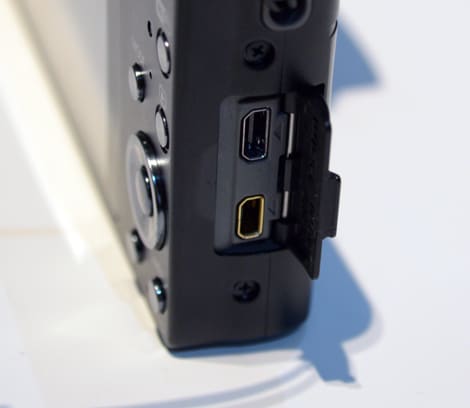
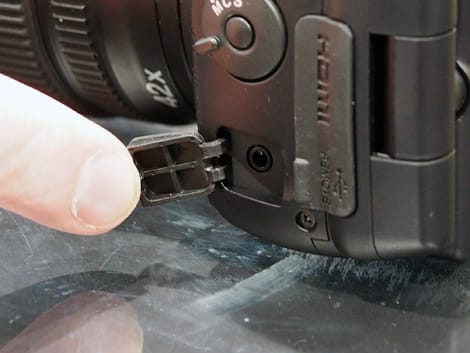
Battery
{{section_header}}{{section.name}}{{/section_header}}
The K-5 is powered by a single D-LI90 battery, which Pentax claims will shoot about 450 images on a single charge, or shoot about 440 minutes of video. If you need to keep going for longer, Pentax does offer a battery grip (the D-BG4) that adds a second D-LI90 battery or a set of 6 AA rechargeables.

Memory
{{section_header}}{{section.name}}{{/section_header}}
Images are stored on a single SD/SDHC Card slot. This will be upgradeable via firmware to support the newer SDXC cards that are now available.
{{product.manufacturer_specs['FI Memory Photo']}}
Other Hardware
{{section_header}}{{section.name}}{{/section_header}}
Electronic Level - The K-5 offers an electronic level when shooting in live view mode which helps to make sure that you are holding the camera level to the ground. This appears on the back screen of the camera.
HDR Mode - The K5 also offers HDR shooting, where it takes two images at different exposures and combines them to form a single image with a wider dynamic range than the camera can capture in one image.
Ease of Use
{{section_header}}{{section.name}}{{/section_header}}
In our limited time with the K-5, we found it to be an intuitive and easy to use camera. It is a complex camera, though, and the number of buttons and features on offer may be off-putting for some users. However, the layout of these is logical and consistent, so it should not take long to learn the layout and find your way around without thinking about it. The on-screen menu is a little overcomplicated though, with the options there divided up into 5 tabs, each of which contains various sub-sections (there are 5 for the configuration tab). This often means quite a lot of scrolling around to reach the one you need.
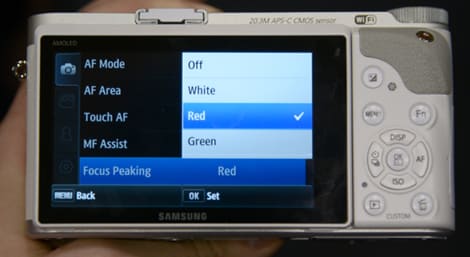

Size & Handling
{{section_header}}{{section.name}}{{/section_header}}
The K-5 is a fairly hefty camera, but it fits well into the hand, with a natural feel and a good tight grip. The contoured plastic coating should ensure a firm grip with sweaty hands. And speaking of sweat: Pentax claims that the body of the K-5 is well sealed against dust and moisture with a large number of rubber seals. We were not able to verify this claim by getting the camera wet, but it certainly feels solid and well constructed, with the port covers snapping tightly into place and the whole camera body feeling robust.
When holding the camera, the index finger falls naturally onto the shutter, and the thumb of the right hand falls onto the control dial and AE-L (exposure lock) button. Additional buttons are in close reach, such as the live view and AF mode buttons. There are also a number of dials on the front of the camera close to the lens: a switch there controls the focus mode, and another button switches the camera between saving JPEG and RAW images.

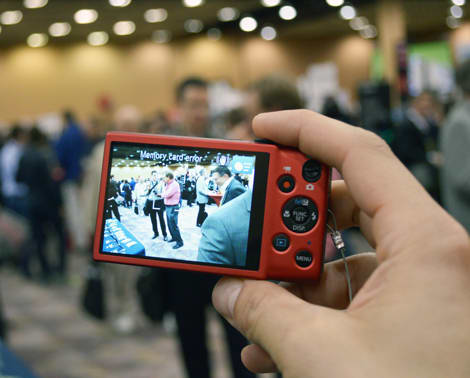
Auto Mode
{{section_header}}{{section.name}}{{/section_header}}
The K-5 offers a full auto mode if you turn the mode dial to the green square setting. In this mode, the camera takes total control, leaving you only the option to change the image size and quality and tweak a few minor settings. Otherwise, the camera takes total control, choosing the settings for everything else. We were not able to judge the quality of this mode from our limited testing.
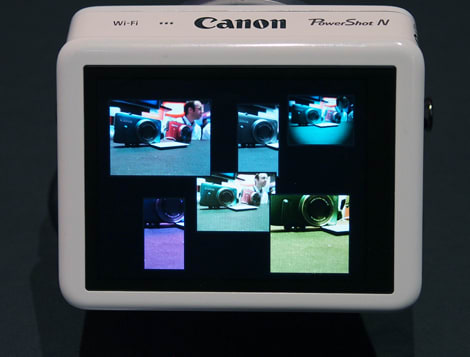
Movie Mode
{{section_header}}{{section.name}}{{/section_header}}
The K-5 has a good selection of movie shooting features, capturing videos at 1080p resolutions (1920 by 1080 pixels). However, at this resolution, the video is limited to 25 progressive frames per second, much less than the 30 or 60 fps that your HDTV prefers. It can shoot video at 30 full progressive frames per second at lower resolutions (such as 720p, which is 1280 by 720 pixels), but not at the highest resolution. Unusually, there is no option to save video at standard definition resolutions. The K-5 can record video at lengths of up to 25 minutes: after that, the image sensor has to cool off before shooting can resume.
The K-5 includes a built-in mono microphone, but you would be much better off using a better external microphone, which can connect to the dedicated microphone port. Video files are saved in Motion JPEG AVI files, which should be compatible with most video editing applications.
Playback Mode
{{section_header}}{{section.name}}{{/section_header}}
A good selection of playback features are available, including the ability to view up to 81 thumbnails on screen and to sort images by date or folder and to do basic editing on files, such as rotating, resizing, cropping and extracting still frames from a movie. Basic slideshows can also be created.
Custom Image Presets
{{section_header}}{{section.name}}{{/section_header}}
The K-5 does not offer scene modes in the normal sense, but it does offer a number of what it calls "Program Lines", which control how the automatic modes. Setting this to the sport option, for instance, pushes the camera to use a higher shutter speed, while the landscape setting favors wider apertures to give a wide depth of field.

Drive/Burst Mode
{{section_header}}{{section.name}}{{/section_header}}
Shooting in the Continuous-Hi mode, Pentax claims that the K-5 can manage a maximum speed of around 7 frames a second, which it can maintain for a batch of 22 JPEG files or 8 RAW files. If you need to shoot for longer, you'll need to switch to the Continuous-Lo mode, which can manage 2 fps, but which can shoot JPEG images until the memory card fills up. We were not able to test the veracity of these speed claims, but we did find that the K-5 was a speedy shooter in our informal tests.
Manual Controls
{{section_header}}{{section.name}}{{/section_header}}
There are a good selection of manual and semi-manual controls on this camera, with modes for Program, Aperture, Shutter Priority and a full manual mode where the user sets the aperture and shutter directly. In addition, there is a B (for Bulb) mode on the shutter dial, where the shutter will stay open for as long as the shutter button is pressed down.
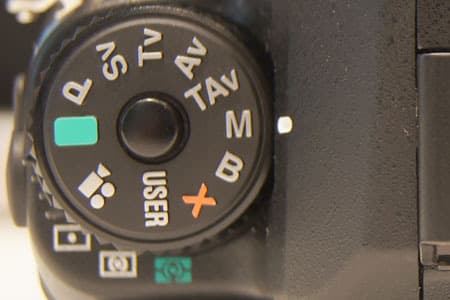
The K-5 also offers three unusual additional modes on the mode dial. First is a Sav, or sensitivuty prioriy mode, where the camera works to set the ISO as low as possible. Next is TAv Priority mode, which is a hybrid shutter and aperture priority mode, where the camera picks settings and you can tweak either the shutter or aperture settings directly. The X mode is for shooting with the flash at faster shutter speeds (up to 1/180 of a second) and the User setting offers 5 user defined groups of settings. You can specify which one of the 5 options is the default chosen when the mode dial is set to User in the on-screen menu.

Focus
{{section_header}}{{section.name}}{{/section_header}}
The auto focus of the K-5 is one area where there have been a lot of improvements, with Pentax claiming that it is significantly faster than other cameras. We weren't able to do a full test on this, but it certainly seemed to be extremely nippey in our informal tests, finding the right focus spot very quickly.
The K-5 offers 11 focus points, with the 6 of these nearest the center bieng the cross types that works better in low light. There are three focus modes, controlled by a switch near the lens. In AF-C mode, the system continually focuses as long as the shutter is half pressed down. In AF-S, the camera focusses one time when the shutter button is pressed down. A manual focus mode is also provided, where the user focuses the camera by rotating the front element of the lens.
When the camera is in live view mode, it uses the image sensor to focus. When this is happening, the camera zooms in on the chosen focus spot to show the focussing in action. This can be disabled if you don't like the effect, which is good as it is somewhat disorientating.
ISO
{{section_header}}{{section.name}}{{/section_header}}
K2000 scored well in our noise tests. but we will have to wait to get the K-5 into our labs before we know how noisy the images get at higher ISO levels.
White Balance
{{section_header}}{{section.name}}{{/section_header}}
The K-5 offers 8 white balance presets (including 4 variants for fluorescent lighting) and a full auto mode. An evaluative mode is also offered, as well as a mode where you input the kelvin value directly.
Exposure & Metering
{{section_header}}{{section.name}}{{/section_header}}
The usual options are on offer for exposure modes: a switch below the mode dial allows you to select evaluative, center weighted or spot metering.
Shutter Speed
{{section_header}}{{section.name}}{{/section_header}}
The wide shutter speed range of the K-5 goes from a minimum of 1/8000 of a second out to a maximum of 30 seconds. A bulb mode is also offered, which allows you to hold the shutter open for as long as the shutter button is pressed
Aperture
{{section_header}}{{section.name}}{{/section_header}}
As an SLR, the aperture range of this camera is determined by which lens you choose. If you go with the kit that Pentax is offering, you will get an aperture range of f/3.5 - 5.6 from the 18-55mm zoom lens that they include. That's an average range for a lens of this type.
Image Stabilization
{{section_header}}{{section.name}}{{/section_header}}
Pentax uses an image stabilization system that is based on a combination of sensor shift and post-processing, which means that the image sensor itself shifts in response to camera shake, and the camera processes the images after they are captured to reduce blur. This approach means that the lens is not involved in image stabilization, so it will work with all lenses, both new and old. The downside is that this approach is often less effective than a system using a shifting lens element, but we will have to wait and see until we get a camera into our test lab to test how effective the K-5 is at reducing blur from camera shake.
Picture Quality & Size Options
{{section_header}}{{section.name}}{{/section_header}}
The largest images that the K-5 can capture are 16.2 megapixels, with a resolution of 4928 by 3264 pixels. The camera does offer three other resolution options though, with the smallest being 2 megapixels (1728 by 1152 pixels). Three quality levels are offered for JPEG images: Premium, Best and Better.
The K5 can also capture RAW images, which capture the raw information from the image sensor, which produces the largest files, but also the highest quality. These files can be saved as either .TK format images (Pentaxes own raw format) or as .DNG (Adobe Digital Negaitve) format, which is more widely supported as a raw format. In addition, there is a RAW+ mode which saves both the RAW image and a JPEG version.
Picture Effects
{{section_header}}{{section.name}}{{/section_header}}
Pentax seems to like putting cute image processing filters on their cameras, and the K-5 is no exception, with 7digital filters including a fisheye distortion effect and a Toy Camera filter that makes the photos taken with the expensive K-5 look like they were taken with a cheap camera from 50 years ago.
Conclusion
The K-5 will cost $1599.99 for the body alone, or $1749 for the camera and an 18-55mm zoom lens when it is released in October. That seems a little expensive, especially with the announcement of cameras like the Nikon D7000 that capture similar resolutions, but which cost a little less. But the K-5 does have a few things going for it: it feels more solidly built than many SLRs, so it should survive a trip into the wilds without problems. It also seems to have speedier AF than other cameras, although we will have to wait and see how that holds up in different conditions and with different lenses. It also boasts a wider ISO range than others, topping out at a low light busting 51200 ISO. But again, we will have to wait and see how noisy the images at these high ISO levels are: having a high ISO is no use if the images are too noisy to use. So, it remains to be seen if these features are worth the extra cost of the camera. We'll look forward to getting a review model in to try out and find out.
Sample Photos
{{section_header}}{{section.name}}{{/section_header}}
Specs
{{manufacturer_specs_table}}
Meet the tester
Richard Baguley is a veteran writer who has written about technology ranging from Alphabet to Zip file utilities. He has contributed to pretty much every major tech publication, including Amiga Format Magazine, PC World, Wired, CNET, Toms Guide, Forbes, and many others. He lives in the Boston metro area with his wife, dog, and an indeterminate number of cats.
Checking our work.
Our team is here to help you buy the best stuff and love what you own. Our writers, editors, and experts obsess over the products we cover to make sure you're confident and satisfied. Have a different opinion about something we recommend? Email us and we'll compare notes.
Shoot us an email